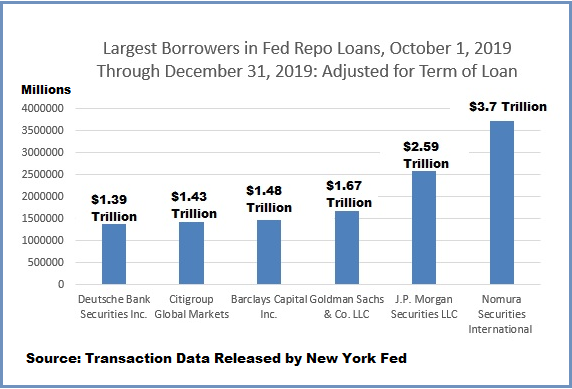By Pam Martens and Russ Martens: January 30, 2023 ~

Jamie Dimon Sits in Front of Trading Monitor in his Office (Source — 60 Minutes Interview, November 10, 2019)
According to a Yale School of Management study, in 2013 JPMorgan Chase had 1,339 hedge fund clients. As of July of last year, that number had soared to 4,281 according to the annual Convergence Inc. study.
While Goldman Sachs and Morgan Stanley topped the total number of hedge fund clients (with 5,150 and 4,964, respectively) JPMorgan Chase ranked number one in terms of hedge fund Assets Under Advisement (AUA). (See Convergence Inc. study linked above.)
There’s a big problem here that federal bank regulators are choosing to ignore at the peril of the U.S. financial system.
JPMorgan Chase, unlike Goldman Sachs and Morgan Stanley, is the largest federally insured, taxpayer backstopped, depository bank in the United States with more than $2.47 trillion in deposits as of June 30, 2022. Unfortunately, as a result of the repeal of the Glass-Steagall Act in 1999, this mom and pop depository bank with more than 5,000 Chase bank branches spread across the United States, is also allowed to make wild trading gambles. Those trading gambles have resulted in felony charges by the U.S. Department of Justice for rigging the foreign exchange markets, the U.S. Treasury market and the precious metals markets.
Even without the dramatic growth of its risky hedge fund business, JPMorgan Chase already ranked as the riskiest bank in the U.S. The data comes from the National Information Center, a repository of bank data collected by the Federal Reserve. The National Information Center is part of the Federal Financial Institutions Examination Council (FFIEC), which was created under federal legislation and imposes uniformity in how U.S. financial institutions are examined by federal banking regulators.
The National Information Center creates an annual profile of banks, measured by 12 systemic risk indicators. The data used to create these graphics come from the “Systemic Risk Report” or form FR Y-15 that banks are required to file with the Federal Reserve. To measure the systemic risk that a particular bank poses to the stability of the U.S. financial system, the data is broken down into five categories of system risk: size, interconnectedness, substitutability, complexity, and cross-jurisdictional activity. Those measurements consist of 12 pieces of financial information that banks are required to provide on their Y-15 forms.
The data for the period ending December 31, 2020 showed that in 8 out of 12 measurements – or two-thirds of all systemic risk measurements – JPMorgan Chase ranked at the top for having the riskiest footprint among its peer banks.
One of the 12 financial metrics is based on the Intra-Financial System Liabilities of each bank. This shows how much money a particular bank has at risk at other banks by using inputs such as how much of its funds it has on deposit with, or has been lent to, other financial institutions; the unused portion of any credit lines it has committed to other financial institutions; and its holdings of debt, equity, commercial paper, etc. of other financial institutions. The idea is to understand the interconnectivity of systemically-risky megabanks and whether one distressed megabank could cause a daisy-chain of contagion with other megabanks — such as the contagion caused by Citigroup and Lehman Brothers during and after the financial crisis of 2008.
JPMorgan Chase’s footprint for Intra-Financial System Liabilities is very large. The 2020 data show that JPMorgan Chase has $577 billion exposure in that category. That’s an increase of $182 billion over what it showed in that category in 2019 – an increase of 46 percent in one year.
The Chairman and CEO of JPMorgan Chase, Jamie Dimon, likes to perpetually brag about the bank’s “fortress balance sheet.” Unfortunately, that bragging isn’t supported by the bank’s felony history or the fact that the bank lost $6.2 billion gambling in exotic derivatives in London during the leadership tenure of Dimon: the so-called “London Whale” scandal.
Then there is also the fact that the Federal Reserve has yet to explain why a unit of JPMorgan Chase (J.P. Morgan Securities) needed to secretly borrow a cumulative $2.59 trillion in emergency repo loans from the Fed in the last quarter of 2019 – long before the first case of COVID-19 appeared in the U.S. (See chart below.)
Perhaps it’s time for the Senate Banking Committee to take a long, hard look at what’s really under the hood of this banking behemoth.
Related Article:


